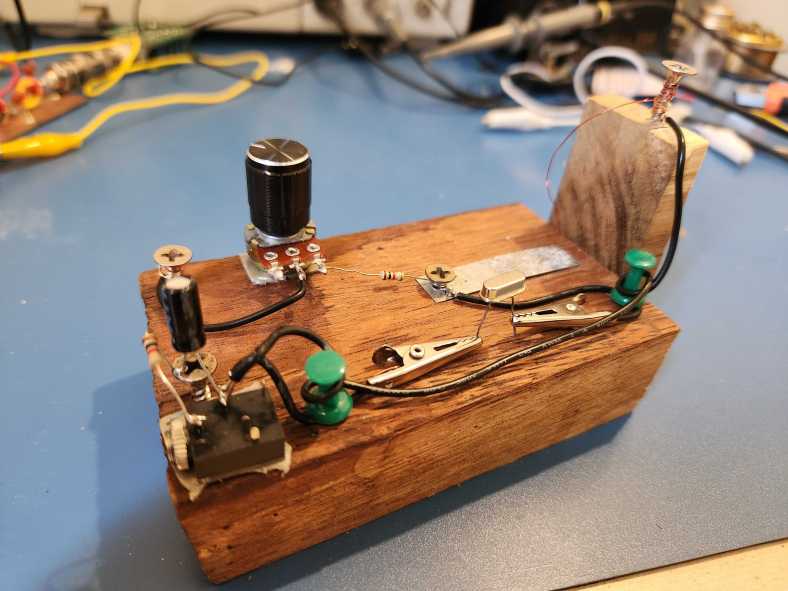This has to be one of the most bizarre projects I have worked on. It is a transmitter that works without any transistors or tubes. It utilizes a strange phenomenon known as quantum tunneling. Quantum tunneling is a phenomenon wherein a particle can disappear from one side of a barrier and reappear on the other side even if it doesn’t have sufficient energy to surmount the barrier. It seems as if the particle “tunnels through” the barrier, hence the name. Quantum tunneling is a consequence of the wave nature of matter. It is nothing less than magic.
The first semiconductor devices to utilize this phenomenon were invented in the 1950s and were called tunnel diodes. These devices exhibit negative resistance, which means that the current through the semiconductor becomes inversely proportional to the voltage across it. This only happens at certain voltages. Below and above that negative resistance region, the tunnel diode exhibits a normal current-voltage relationship.

This negative resistance anomaly allows tunnel diodes to be used in very high-frequency oscillators. Tunnel diodes are an exotic breed of semiconductor devices. Commercially made ones are rare and expensive. However, recently, a genius inventor by the name of Nyle Steiner discovered an easily made substitute. He found out that he could make tunnel diodes at home by heating galvanized sheet metal!
Anyone with a propane torch and a few scraps of galvanized sheet metal laying around can easily make a negative resistance device. With this device, it is possible to make very simple RF oscillators, audio oscillators and even amplifier circuits. It is almost like making your own transistor.
Nyle Steiner
Mr. Steiner has some of the most interesting experiments I have seen, so do check out his website – http://www.sparkbangbuzz.com/.
I recreated the experiment by heating a zinc metal plate with a torch. The back side of the zinc plate (opposite from the flame) had several active spots. These black spots are where you are most likely to find negative resistance. I used a “cat whisker” style detector similar to the ones used in crystal radios to probe the zinc plate. For the “whisker”, I used #30 AWG copper wire.


I’ve used a 4 MHz crystal to set the frequency of the oscillator. The 10K pot is used to adjust the biasing. The 1K resistor was initially added to reduce short-circuit current when the pot is at its lowest setting. This resistor may no longer be necessary after I added a 1K resistor in the keying circuit (which consists of a CW straight-key, 1K resistor, and an electrolytic capacitor). The keying circuit was a later addition, so I forgot to remove the 1K from the biasing circuit. The resistor and electrolytic capacitor on the keying circuit serve an important purpose. They smooth out the keying. The charge on the capacitor prevents the voltage on the cat-whisker from changing abruptly. For some reason, the homemade tunnel diode doesn’t like abrupt keying. Without the smoothing circuit, there are many cat-whisker settings that stop working after opening and closing the key. These oscillators are quite fussy.
Adjusting the cat-whisker is time-consuming task. Be prepared to spend several minutes trying to find good spots. The easiest way to know if the circuit is oscillating is by using a radio or an oscilloscope. I tuned my Icom transceiver to the frequency of the crystal (4 MHz) and kept it nearby in CW mode. You will hear clicks and beeps as you slide the cat-whisker. If you don’t, adjust the biasing. Finding a stable spot can take a while, but once you’ve found it, it can last for a long time if you don’t disturb it. In my experiments, I was able to use a spot for an entire day. It would have lasted longer if I hadn’t disturbed it.

Here is the “quantum tunneling transmitter” in action:
I will try injecting an AM audio signal into the oscillator. I’m sure that would also work. If only the professor on Gilligan’s Island knew about it!
